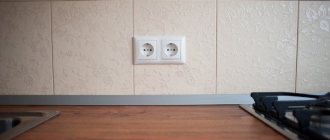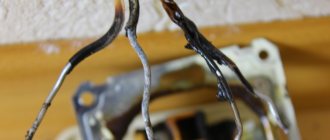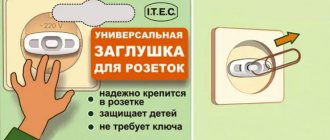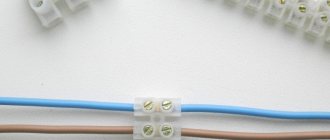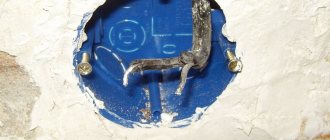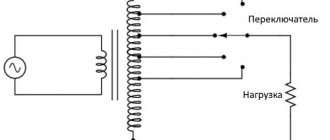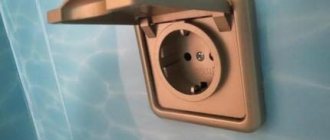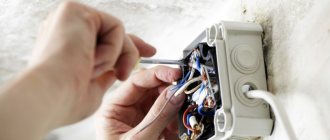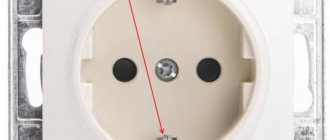Home » Electrical wiring » Sockets » Special sockets with child protection
Almost all parents will say that the most valuable thing in life is a child. There are a large number of outlets in the house, and they are the most dangerous source for your children. That is why protected sockets will be your reliable protector. Many carry out explanatory work. When telling a child that it is dangerous, he may not always understand you and not do it. Children always try to do something against their parents. When a child is really interested in something, he can simply forget about your prohibition. That is why special sockets for children or various devices will come to your aid, which we will talk about in more detail in this article.
Childproof sockets are the best way to protect your child and keep him healthy
How to ensure effective protection?
Be as careful as possible in your choice, because not everything may actually be safe. First you need to understand the mechanism of the plug structure.
The most common option looks like a regular flat plug, with two plastic pins built into it. It does not conduct electricity and is safe. If all sockets have such plugs, and the child cannot get this plug out of there, then he is completely protected from accidental electric shock. Such plugs are quite cheap: 150-200 rubles for a set of 10 pieces, and their installation takes seconds.
Here is the most popular model on Aliexpress (the largest Chinese online hypermarket) - link. This model has already been ordered more than 1,700 times, with a rating of 4.9 stars.
Below are photos from reviews:
Perfectly protects connectors from children and children from the socket
Children are very restless, they try to explore the whole world with the help of tactile sensations. Therefore, simply prohibiting your child from touching the socket is not enough; on the contrary, you can provoke him to take active action.
Very complex mechanisms were opened by children quite simply. For example, there are plugs that can be opened by simply inserting a plug into them, for example from charging. Children remember what their parents do and easily repeat it.
A more reliable version - with a special key that you should always keep with you and not lose
It is important that the key is not left in a visible place, otherwise it will be the first thing the child takes
Electrical wires and children
A child can also receive electric shock from devices that are connected to the electrical network. For example, this could be a table lamp, floor lamp, electric heating device and other electrical appliances. You can simply limit children's access to electrical equipment, but this is not the only measure that can protect children.
First of all, it is necessary to teach children basic safety rules. It is best to teach a child in a playful way; for this you can use special educational children's cartoons, and discuss them after watching them.
Educational cartoons look something like this:
A joint lesson on safety from electric shock, which is usually carried out in children's institutions, has a special influence on the actions of children.
It is important that children participate in such collective activities that allow them to exchange their impressions with other children, because this will contribute to the formation of a stable consciousness of correct behavior in different life situations
As children get older than five, their parents try to give them more freedom and therefore control them less. Children can play outdoor games with peers on the street without supervision, or ride bicycles
By this time, it is very important that the child has clearly developed knowledge that will protect them from electric shock.
He must clearly understand the following facts: electricity is transmitted through cables and poses a serious danger to people's lives. Under no circumstances should you play under electric poles, climb on them, or throw objects onto the wires.
It is also important to note that not all games can be played near power lines. For example, you can only play with a kite away from main power lines
After all, air currents can pull the kite onto the wires, and this can also lead to electric shock.
Also, distribution cabinets, as well as transformer substations, which are usually installed in the courtyards of multi-story buildings, pose a great danger to children. Children must understand that going beyond the fence to electrical equipment is strictly prohibited. Such information can protect the baby from electric shock.
By the time the baby is allowed to be outside on his own without adult supervision, he should have developed the instinct:
- Do not under any circumstances approach the fence that encloses electrical equipment;
- do not approach broken or loose cables;
- if any violations are noticed, immediately inform adults;
- It is strictly forbidden to play near electrical poles.
The older children get, the more dangers there are, and the danger can come from more than just the electrical outlet in the house. After all, for example, while going to school, he may come across broken wires, which can lead to very sad consequences.
If a child is left alone in an apartment, he should not:
- Remove protection from household appliances, replace light bulbs or fuses, and carry out other repairs.
- Touch working electrical appliances with wet hands, and even more so wash or wipe them with a wet cloth.
- Turn off or turn on electrical appliances yourself.
It is very important that parents do everything possible to protect their baby from electric shock. We hope our tips have helped you ensure that your children are adequately protected from outlets and electrical appliances at home.
It will be useful to read:
- How to make lighting in a children's room
- How to hide sockets in an apartment
- What is IP protection degree
- Ideas for masking wires in an apartment
An everyday problem from a dangerous perspective: electricity and children
Parents, knowing the child’s desire to try what’s inside the socket or switch, conduct explanatory conversations with their child.
However, one cannot be sure that without parental control the desire to disassemble an electrical appliance or check the current in an outlet, as dad does, will not arise.
Regardless of the age of children, you need to worry about safety.
Sockets and switches in the house must be protected.
We will discuss further what this protection is like, how it works, and what its possible disadvantages are.
According to the norms and rules of “Design and Construction”, there are generally accepted standards that imply the possibility of installing sockets (relative to the floor) at a distance of 30 cm, switches - 85-90 cm. Therefore, even a small child is able to get to an unprotected electrical point.
Pull-out sockets in furniture elements
Many furniture manufacturers already install hidden retractable socket blocks in production, with factory connectors for connecting to the wiring. Sometimes this is done at the request of the customer, or the customer can do it independently. All elements for this are sold in specialized furniture centers and electrical goods stores.
Example of installing an Evoline Port unit into a countertop or wall-hung cabinet bottom
Very often there is a need to connect additional household appliances, sockets for which were not previously provided. Perhaps they are often not in demand, but there is a need. To do this, it is very convenient to use retractable factory-made socket blocks, which are carefully disguised in the furniture body and can be easily pulled out if necessary.
A significant advantage of modern retractable units is the ability to connect smartphones for charging. To do this, they provide special connectors of various standards or a USB connector with transition to another standard. The blocks can be connected to local computer and telephone networks; USB and RJ45 cords are pulled out of the block at a distance of up to 3 m; when disconnected, the wires are automatically rolled up inside the block.
Connecting the Laptop to a 220V network and local Internet network via a retractable block
Effective protection and features for choosing the right outlet plugs
Here are some criteria that we recommend taking a closer look at:
- Quality plastic, stability. This means that it is not allowed to purchase products made from fragile materials.
- Strong position of sealing inserts.
- Fastening and additional elements must match the socket itself. For installation indoors and outdoors, with or without grounding.
- Socket type. Each variety has its own modification of plugs.
Types of child protection plugs
Most often, a plug for an outlet is a flat-shaped plug made of dielectric material, so that it is impossible for a child to pull it out. The pins inserted into the sockets securely secure the plugs. By placing them throughout the apartment or house, you can protect small family members from exposure to electrical voltage.
However, there are more advanced protection devices that cover the outlet. They are equipped with a key, which additionally secures it in sockets.
So, plugs can be divided into three main types:
- Internal. They are made of plastic and protect children using a regular latch;
- Rotary. You can remove it and install it in the socket using a special rotating mechanism; in order to pull it out or get inside, the child will have to not easily pull it out but also turn the mechanism;
- Castle ones. This is a reliable locking mechanism with a locking element that can only be opened with a key. This type is suitable for children of any age. Locking plugs are the most expensive. but also the most reliable devices.
The market is constantly evolving and, due to the growth of technology, the variety of plugs that are designed to protect a child from electric current is also growing. Here are a few more types of stubs:
Waterproofing. Made of plastic with an additional sealing gasket made of rubber or silicone. They are used in very humid rooms in order to stop the flow of moisture and humid air into the outlet. And thereby prevent oxidation and short circuit. Decorative. The main functional feature of these products is not to harm the design of the room and make the interior more attractive
Such devices can even simply disguise the outlet, thereby excluding children from paying attention to them. They vary in shape and color. Plugs for socket boxes
This type is used if, as a result of repairs or during repairs, wire outlets for installing future sockets remain uncovered. Well, or simply the repair is done in one day and the outlet has not yet been installed or purchased, and a child or an adult may accidentally touch the live wires.
Types of plugs
Protective devices are classified as follows:
- Plugs to prevent access by children. The main condition for such devices is the impossibility of open access to the connector. A child will not be able to insert the plug into a child-proof socket. Protective devices are equipped with rotary or push mechanisms that operate only when a conventional electrical plug is used. Sockets with curtains are also available, the shutter mechanisms of which can only be opened with a key.
- Temporary plugs for socket boxes. They are used during repair work when it is necessary to prevent accidental contacts with wiring brought out into the socket box.
- Plugs used to protect electrical wires from moisture. They are used in rooms characterized by high levels of humidity. The devices are made from dense rubber or silicone. To remove such a plug from the connector, there is no need for a special device; as a result, the proper level of safety for children is not ensured.
- Decorative plugs. Designed not only to protect children from electric current, but also improve the aesthetics of the room.
- Protective cases. They are used not only to protect sockets from children, but also to equip extension cords with them. The cases are mounted using plug connectors.
Protective case for extension cord
Extension cords must also be child-safe. The industry produces special pencil cases that block access to the extension cord. It is possible to adjust the length of the pencil case, which is very convenient when new current consumers appear in the room.
The cases have connectors for plugs. It is desirable that the lid of the pencil case be opaque. This circumstance will reduce the child’s interest in the object of potential danger.
Expert opinion
It-Technology, Electrical power and electronics specialist
Ask questions to the “Specialist for modernization of energy generation systems”
Protecting children from electric shock - what is important to know Also, distribution cabinets, as well as transformer substations, which are usually installed in the courtyards of multi-storey buildings, pose a great danger to children. Ask, I'm in touch!
Classification of the degree of protection of sockets
Industrial manufacturers make products with increased protection according to IP classification. Outdoors it is recommended to install sockets of class IP 44 or IP65, the first digit indicates the degree of protection from dust:
- 0 – without protection elements;
- 1 – from particles larger than 50 mm;
- 2 – particles from 12 mm;
- 3 – particles from 2.5 mm;
- 4 – particles from 1 mm;
- 5 – protects against very fine dust;
- 6 – complete exclusion of dust ingress.
Table of the degree of protection of sockets from moisture and dust
The second digit indicates the degree of protection from moisture:
- 0 – no protection;
- 1 – penetration of vertically falling drops is excluded;
- 2 – ingress of water is excluded, from drops at an angle of 15°;
- 3 – from splashes flying under a clone up to 60°;
- 4 – protection from any splashes;
- 5 – from water jets at any angle;
- 6 – holds back the flow of powerful jets of water;
- 7 – short-term immersion in water is allowed;
- 8 – operation under water is allowed.
Example of hidden sockets on the street
Moisture protection class
For the bathroom, you should choose sockets equipped with reliable protection from moisture. These devices differ not only in design, but also in their protection class, which is reflected on the case with special markings: the letters IP and two numbers.
The first indicates the degree of protection against the penetration of solid particles, the second - the level and features of resistance to moisture. In bathrooms, it is recommended to use sockets with a protection class of at least four. IPx5 and IPx6 class devices are even more reliable, so if possible, you should prefer such devices.
They are quite capable of withstanding even strong flows of water.
This diagram clearly demonstrates the level of protection of electrical appliances from external factors. This information will help you choose suitable sockets for the bathroom
For the bathroom, it is recommended to choose sockets that are closed with a special protective cover. It is securely pressed with a spring, preventing accidental opening. The lid must fit very tightly to the body; even small gaps are unacceptable.
If additional effort is required to close/open the protective cap, this indicates the reliability of the device. If the lid is slightly loose, you should not install such an outlet in the bathroom; its level of protection from moisture may not correspond to the declared characteristics.
Sockets with a high level of protection against moisture are equipped with a special cover, which must fit tightly to the body of the device
Sockets with a cover, but with a low level of protection against splashes, are used in residential areas as an option for a device that is safe for small children. Therefore, a device equipped with a protective cover should not automatically be considered waterproof.
It is imperative to check the specifications and markings of the outlet. To increase the tightness of the device, protected from moisture, a special rubber edging is used.
You cannot use tiles with holes instead of the body of a waterproof socket. It looks original, but moisture can easily get into the contacts and cause serious problems.
The level of protection of the entire electrical system in the bathroom will not be reliable if the electrical wiring is incorrectly selected. A standard cable is not suitable for such situations; a wire with a special protective braid that provides double insulation is required.
Unfortunately, the electrical appliance market is not immune to counterfeits. To increase the likelihood of purchasing quality equipment, you should contact reliable stores and give preference to products from well-known brands.
Do not neglect the opportunity to familiarize yourself with the quality certificate for the selected devices.
Classification
Why do you need plugs for sockets? You can expect anything from children, especially restless and curious ones. They are able to find trouble where, it would seem, nothing threatens them. One of the most dangerous objects is an electrical outlet. To protect the child from electric shock, they resort to the help of the devices we are considering. Products are conventionally divided into three types:
- internal;
- rotary;
- castle
The first type consists of a plastic device that locks the socket by snapping it into place. The second type can be extracted using physical pressure. The third modification opens only after using a special key.
Models with the simplest design are included in the lowest price segment. A plug for an outlet with a more complex device will cost more. The highest cost is for high-strength locking systems.
The electrical goods market offers not only plugs for childproof sockets. There are also these types:
- Waterproofing. They are distinguished by increased density. Made from plastic. Equipped with additional protection made of rubber or silicone. After their installation, the flow of moist air to the internal parts of the outlet is completely blocked.
- Decorative plugs for sockets. It is better to hide the keys from children who show curiosity about these bright and beautiful details. Otherwise, attempts to open products with their help will not take long. The function of such models is to make the interior of the room more attractive. The samples are distinguished by unusual colors and shapes. Allows you to disguise the outlet.
- Plugs intended for socket boxes. They are designated as a variation of the previous type of product. If you still have open entrances in your wall after renovation, use these models to close them.
Self-production of plugs
You can make a protective device yourself. This will reduce financial costs, but will require some labor and time.
- Work should begin by measuring the dimensions of the inside of the outlet.
- Take a plastic sheet 2 millimeters thick or more.
- Make a round piece from plastic that matches the size of the socket.
- Make holes in the part for the central screw and entrances.
- Remove the existing screw in the box, replacing it with a longer one.
- Fix the plastic part in the box by turning it 90 degrees.
An indoor socket is an attractive object for a child to explore. Protective devices in the socket (plugs, pencil cases) are a reliable way to protect children from electric shock and guarantee peace of mind for parents.
FAQ
Question No. 1. What cross section should I lay the wires for the main sockets and additional ones?
The cross-section of the wires depends on the power of electricity consumed by the devices, therefore, for powerful household appliances that are constantly in use, it is necessary to calculate the cross-section, this is a separate topic. Statistics show that electric stoves require wires with a cross-section of at least 6 mm2, for air conditioners and split systems 4 mm2, for other consumers 2.5 mm2 is sufficient. To determine, use the table below. The power consumed by the equipment is written on the body tags and in the product passport.
Permissible cross-section of copper wires depending on power consumption:
| Ø wire cross-section in mm2 | Power in kW | |
| Mains voltage 220 V | Mains voltage 380 V | |
| 1.5 | 10,6 | |
| 2.5 | 16,6 | |
| 4 | 8,5 | 4.2 |
| 6 | 10 | 6 |
| 10 | 15,5 | 35 |
Question No. 2. What brand of flex cord should be installed on sockets in drawers?
A good option for these purposes is the KG wire:
| Cable brand | Number of cores | Cross-section of stranded wire | Purpose |
| KG | 3 +1 | 1.5 mm | For lighting networks |
| KG | 3+1 | 2.5 mm | For additional sockets |
| KG | 3+1 | 4 mm | Washing machine |
| KG | 3+1 | 6 mm | Electric furnaces |
Question No. 3. Can the refrigerator be connected to additional retractable sockets?
With a wire cross-section of 2.5 mm2 it is temporarily possible, long-term operation is not advisable, it is recommended from an individual wall socket.
Question No. 4. How to connect telephone JR45 and USB from a common line in a retractable socket?
They are sold through special splitters in computer and radio equipment stores.
How to insert a plug into a protected outlet
The installation of a protective mechanism in the outlet is carried out by the parent, and depending on the type of protection, access to the power supply is ensured at the right time.
An adult should not have any difficulties with this use. For example, if these are overhead curtains that open when pressed, then after an adult presses the base, access to the socket will open.
With rotating mechanisms everything is also simple: when turning in the right direction (usually with an electrical plug), access to the network is also provided.
If the protection is with a rotary security key, then all that is needed is to open the protective plastic panel with the key.
If it is not possible to buy a plug for the socket, you can make one from improvised materials. From any plastic (wall thickness at least 2 mm) or carbolite, cut a circle with a diameter the same as the inside of the socket. Drill three holes, two of which will coincide with the plug. The third hole in the middle to tighten the plug with a screw from the socket. When loosened, such a mechanism turns and the electrical device turns on; when tightened and turned, access is blocked.
Guidelines for choosing a bathroom device
Let's move on directly to the algorithm for selecting and installing moisture-resistant sockets for our bathroom. As already noted, the classic modern bathroom is a room where a sufficient number of electrical appliances and devices are concentrated.
In order not to make a mistake in choosing an electrical installation product, you should consider:
- Socket protection class. The minimum is IPX4 class, the optimal is IPX5 or IPX6 class, it is not rational to buy anything equal to or greater than 7.
- Design, color and shape. As they say: “There are no comrades according to taste.” When choosing a socket for the bathroom, you need to take into account the size, shape, presence of a cover, back panel, etc., in order to harmoniously fit the product into the overall ambience of the room.
- Number of connectors. The standard is the use of two multi-block socket connectors. One is used to connect large equipment (an automatic washing machine, hydromassage and other water therapy systems), the second is used for “small” electrical household appliances (hair dryer, razor, dryer, extractor hood, additional room lighting).
- Separate machine. When installing moisture-resistant sockets in the bathroom, you need to provide a separate power supply line for them. In addition, connect all these outlets through the emergency shutdown unit in the distribution panel. Sockets must be grounded.
There are also special requirements for electrical wiring. The material of the power cables is copper; the cable should be laid in the wall only if there is a special PVC box.
Installation of waterproof sockets is carried out according to rule 60, that is, the product must be placed at a distance from the floor, wall corner, sink, possible drop in water flow of at least 60 cm
It is worth noting that the above reasoning can be easily applied to the selection and installation of waterproof sockets in utility rooms of a private house, basement storage, garages, etc. You can only exclude the requirement of design and “beauty” in relation to the external decorative panel of the outlet.
Why are plugs needed?
The electrical outlet seems quite safe. Adults can generally forget that she poses some kind of threat. But children may well put the first thing in their hand into the socket, which means serious harm.
There are three conditional categories of all stubs:
- internal;
- rotary;
- castle option.
The simplest one is a plastic version that simply snaps on when necessary.
To install the second option of plugs, physical pressure is needed, often so much that the child cannot cope with it. Therefore, it will not be easy to take them out and put them in place every time.
The third option requires a special key that fits all plugs from the set.
Of course, the simpler the plug, the cheaper it is. But the quality of the material can also affect the price
Defective models do not hold up well, and in the end only attract the child’s attention in vain
There are plugs that perform not only a child-proof function. Certain varieties block moisture and humid air from entering the outlet, which means they prevent short circuits and wiring malfunctions. They are made of very durable plastic.
Parents strive to surround their children with beautiful and elegant things, so it is not surprising that decorative end caps have appeared. They must be on the keys so that the child cannot get the toy in any other way. An important task of such options is to make sockets that do not fit into the decor more attractive. They usually look like bright colored animals or figures of unusual shapes.
Device with a rotating mechanism
This device has a very simple operation. When you turn on the plug, you need to turn it, and then it will be inserted into the holes. If you need to take it out, you need to slightly pull it towards you and turn it in the opposite direction. The rotating device is adjusted in one movement, so it is convenient to use.
The security module resembles an ordinary latch and works on the same principle. But a simple mechanism can break over time, so when purchasing, you need to make sure that the plug fits tightly into the hole. A high-quality device made of durable material will last a long time; you shouldn’t skimp on it.
Expert opinion
It-Technology, Electrical power and electronics specialist
Ask questions to the “Specialist for modernization of energy generation systems”
Plugs for sockets from children - purpose and types However, plugs are necessary, especially if a small child spends a lot of time in an adult’s room, where there are many sockets. Ask, I'm in touch!
Danger of electric current for a child
To date, there are no children who are safe from electric shock.
If parents do not take precautions, then your child may also be in danger. If a child tries to insert a fork or other metal objects into the device, then you will not be able to avoid the danger.
This is why many parents prefer special sockets. They are created in such a way that it will be difficult for a child to notice them.
What does the design of a childproof outlet look like?
Also today there are a number of devices that have protective properties. Special sockets can prevent tragedy, but not always. You should never rely on technology, as sometimes it can work too late. In this case, you will not be able to save the child’s life. If we talk about sockets that have a protective device, then you should remember that their installation is appropriate in the bathroom.
Special sockets will help protect not only the health, but also the life of the child. The most reliable and effective method would be to purchase and install an outlet with protective curtains. A closed socket will be almost ideal for installation in areas where small children live. They make life much easier and allow you to protect your child thanks to the unique socket design. Of course, in order to find outlets that have protective curtains, you should spend a lot of time. This is a rather rare product that is difficult to find on the market. But it is thanks to them that you can definitely protect your baby from electric shock.
First of all, these are protective devices that are located on the inside of the outlet. They are attached to the lid and can automatically close the sockets in the socket. Thanks to them, the child simply will not be able to insert foreign objects into the sockets, which will become conductors. Today their range is quite wide. Many manufacturers have begun to produce separate lines of these devices. They reliably protect children from electric shocks.
A rosette with internal curtains is a great option
Also, if you look at all the products, then you may come across internal structures that should be installed in plastic boxes. But when purchasing these devices, you must remember that they are quite difficult to install. Security curtains have more than just these sockets. There are other types of sockets that have them in their design.
Another method of protection includes special plugs. But this method also has its inconveniences. A plug is a small item that can easily be lost. There is also a very high chance that a child will simply pull out your plug.
At the moment, you can buy not only special sockets with protection, but also additional plugs and curtains. After all, when carrying out electrical installations in the house, many parents do not think that in a few years they will have a child who needs to be protected. And don’t forget about saving, no one will immediately overpay. But there is nothing terrible about this, since additional protection can be purchased without much difficulty.
At the moment, there are a huge number of devices that can be installed as child protection on sockets. Among the main ones we highlight:
- curtains;
- plugs;
- plugs with lock.
Curtains are a great way to protect a child, but they can only be purchased together with sockets. What you don’t always want to do.
Many parents use plugs, but they cannot be called effective. After all, sooner or later the child will learn to pull them out of the socket. Therefore, we do not recommend buying them; there are more thoughtful ways.
Locking plugs for sockets are the best solution at the moment. After all, when inserting such plugs into a socket, it is impossible to pull them out without a special key. The cost of such protection is not at all high, but they will bring significant benefits.
A plug for sockets with protection will help out in any situation
Bathroom zoning and electrical safety requirements
Electrical power is necessary in the bathroom to ensure the operation of a number of useful household appliances:
- automatic washing machine;
- electric shavers;
- hairdryer;
- heated towel rail;
- fan;
- hydromassage in the bath or shower, etc.
You cannot choose a place for an outlet in the bathroom arbitrarily, guided only by your own comfort. Safety requirements must be taken into account:
- The horizontal distance from the outlet to the water source should be more than 60 cm.
- The same vertical distance should be even greater - at least one meter.
- Only hidden wiring should be used; the cable is laid in the thickness of the wall or in a special protective box.
- The socket, which is intended for installation in the bathroom, must have such elements as a protective cover, an additional grounding terminal and a rubber seal.
- Each outlet must be grounded.
- The connection points between the cable and the socket must be carefully insulated.
For safe installation of the socket, the bathroom is divided into four main zones:
- The zero zone is not intended for installing power points, since this is the space that directly surrounds the place where water enters (bathtub, shower, washbasin, etc.)
- The first zone is 60 cm from the water source, an area of intense water splashes. You can install a boiler here, but it is better to use other areas for outlets.
- The second zone is a space more than 60 cm away from the water source. Here it is allowed to install sockets with good protection from moisture, as well as elements of ventilation systems, lighting, heated towel rails, etc.
- The third zone is the space that is furthest away from water collection points and is the safest. Here you can install sockets with an average level of protection from moisture, control panels for household appliances, switches, distribution boards, etc.
Sometimes you still have to install sockets in dangerous zones: zero or first. In this case, it is necessary to use a device with the highest possible protection class IPX7. Such a device can operate safely even when completely immersed in water.
This diagram demonstrates bathroom zoning for safe installation of electrical outlets. The second and third zones are the most suitable
Another important condition is the correct connection of sockets in the bathroom to the house or apartment distribution board. To do this, you should allocate a separate line, and also install a protective device to disconnect in case of an emergency
This separate line should not be used to power other devices.
To do this, a separate line should be allocated, and a protective device should be installed to shut off in case of an emergency. This separate line should not be used to power other appliances.
Memo to caring parents
1. Choose the right model so that your child cannot cope with it. Rotary plugs are very dangerous. It won't take much time to figure them out. Therefore, in addition to the obstacles to the outlet themselves, you need to constantly monitor the child.
2. The most reliable way is plugs on the key. But what happens if you lose your key and your child finds it? Perhaps he will immediately go check it on all the outlets in the house.
3. Pay careful attention to the material from which the plugs are made; it should be a very durable plastic that will not collapse from constant “pulling out”.
4. Choose the right plugs for your types of sockets
It is important that they hold well due to the sealing parts
For most modern sockets, plugs are widely available, but, unfortunately, telephone and radio sockets are very difficult to select such accessories. What to do in such a situation? You can make an insulating element with your own hands.
Universal plug for sockets
Protects the child from possible contact with live contacts of sockets. Universal plugs do not require a special key, as they are removed from the socket using a paper clip or bobby pin. The design is made in such a way that a child will not be able to remove the plug with his hands.
